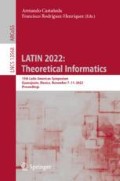Abstract
In this paper, we present a new construction of a finite automaton associated with a rational (or regular) expression. It is very similar to the one of the so-called Thompson automaton, but it overcomes the failure of the extension of that construction to the case of weighted rational expressions. At the same time, it preserves all (or almost all) of the properties of the Thompson automaton. This construction has two supplementary outcomes. The first one is the reinterpretation in terms of automata of a data structure introduced by Champarnaud, Laugerotte, Ouardi, and Ziadi for the efficient computation of the position (or Glushkov) automaton of a rational expression, and which consists in a duplicated syntactic tree of the expression decorated with some additional links. The second one supposes that this construction devised for the case of weighted expressions is brought back to the domain of Boolean expressions. It allows then to describe, in terms of automata, the construction of the Star Normal Form of an expression that was defined by Brüggemann-Klein, and also with the purpose of an efficient computation of the position automaton.
Access this chapter
Tax calculation will be finalised at checkout
Purchases are for personal use only
Notes
- 1.
A topological semiring is strong if the product of two summable families is a summable family. It is a sufficient condition in order to establish Theorem 1. Not all semirings are strong ([19]) but all usual semirings are. This precision is not of importance here but on the other hand Theorem 1 is essential for the constructions that follow and we wanted to have a correct statement.
References
Allauzen, C., Mohri, M.: A unified construction of the Glushkov, follow, and Antimirov automata. In: Královič, R., Urzyczyn, P. (eds.) MFCS 2006. LNCS, vol. 4162, pp. 110–121. Springer, Heidelberg (2006). https://doi.org/10.1007/11821069_10
Angrand, P.Y., Lombardy, S., Sakarovitch, J.: On the number of broken derived terms of a rational expression. J. Automata Lang. Comb. 15, 27–51 (2010)
Berstel, J., Reutenauer, C.: Rational Series and Their Languages. Springer (1988). Translation of Les séries rationnelles et leurs langages Masson (1984)
Berstel, J., Reutenauer, C.: Noncommutative Rational Series with Applications. Cambridge University Press (2011). New version of Rational Series and Their Languages. Springer (1988)
Bloom, S.L., Ésik, Z.: Matrix and matricial iteration theories. I. J. Comput. Syst. Sci. 46, 381–408 (1993)
Bloom, S.L., Ésik, Z., Kuich, W.: Partial Conway and iteration semirings. Fundam. Inform. 86, 19–40 (2008)
Brügemann-Klein, A.: Regular expressions into finite automata. Theoret. Comput. Sci. 120, 197–213 (1993)
Caron, P., Flouret, M.: Glushkov construction for series: the non commutative case. Int. J. Comput. Math. 80(4), 457–472 (2003)
Champarnaud, J.M., Laugerotte, É., Ouardi, F., Ziadi, D.: From regular weighted expressions to finite automata. Int. J. Found. Comput. Sci. 15(5), 687–700 (2004)
Champarnaud, J.M., Ponty, J.L., Ziadi, D.: From regular expressions to finite automata. Int. J. Comput. Math. 72(4), 415–431 (1999)
Droste, M., Kuich, W., Vogler, H.: (ed.): Handbook of Weighted Automata, Springer(2009). https://doi.org/10.1007/978-3-642-01492-5
Eilenberg, S.: Automata, Languages and Machines, vol. A. Academic Press (1974)
Glushkov, V.M.: The abstract theory of automata. Russ. Math. Surv. 16, 1–53 (1961)
Hopcroft, J.E., Motwani, R., Ullman, J.D.: Introduction to Automata Theory, Languages and Computation. Addison-Wesley, 3rd edn. (2006)
Kuich, W.: Automata and languages generalized to \(\omega \)-continuous semirings. Theoret. Comput. Sci. 79, 137–150 (1991)
Lombardy, S., Sakarovitch, J.: Derivatives of rational expressions with multiplicity. Theoret. Comput. Sci. 332, 141–177 (2005)
Lombardy, S., Sakarovitch, J.: The validity of weighted automata. Int. J. Algebra Comput. 23(4), 863–914 (2013)
Lombardy, S., Sakarovitch, J.: Derived terms without derivation. J. Comput. Sci. Cybern. 37(3), 201–221 (2021). arXiv: arxiv.org/abs/2110.09181
Madore, D., Sakarovitch, J.: An example of a non strong Banach algebra (in preparation)
Pin, J.É.: Handbook of Automata Theory, vol. I and II. European Mathematical Society Press (2021)
Rabin, M.O.: Probabilistic automata. Inform. Control 6, 230–245 (1963)
Sakarovitch, J.: Rational and recognisable power series. In: Droste, M., Kuich, W., Vogler, H. (eds.) Handbook of Weighted Automata, pp. 105–174. Springer (2009). https://doi.org/10.1007/978-3-642-01492-5_4
Sakarovitch, J.: Automata and expressions. In: Pin, J.É. (ed.) Handbook of Automata Theory, vol. I, pp. 39–78. European Mathematical Society Press (2021)
Salomaa, A., Soittola, M.: Automata-Theoretic Aspects of Formal Power Series. Springer (1977). https://doi.org/10.1007/978-1-4612-6264-0
Schützenberger, M.P.: On the definition of a family of automata. Inform. Control 4, 245–270 (1961)
Thompson, K.: Regular expression search algorithm. Comm. Assoc. Comput. Mach. 11, 419–422 (1968)
Author information
Authors and Affiliations
Corresponding author
Editor information
Editors and Affiliations
Rights and permissions
Copyright information
© 2022 Springer Nature Switzerland AG
About this paper
Cite this paper
Lombardy, S., Sakarovitch, J. (2022). The Net Automaton of a Rational Expression. In: Castañeda, A., Rodríguez-Henríquez, F. (eds) LATIN 2022: Theoretical Informatics. LATIN 2022. Lecture Notes in Computer Science, vol 13568. Springer, Cham. https://doi.org/10.1007/978-3-031-20624-5_23
Download citation
DOI: https://doi.org/10.1007/978-3-031-20624-5_23
Published:
Publisher Name: Springer, Cham
Print ISBN: 978-3-031-20623-8
Online ISBN: 978-3-031-20624-5
eBook Packages: Computer ScienceComputer Science (R0)

